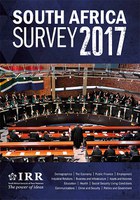
Politics and Government
The 46-page Politics and Government chapter provides up-to-date figures on South Africa’s political landscape. It details party representation at national, provincial, and local level and provides audit performance data on all three tiers. The chapter also covers issues such as government performance, social cohesion, race relations, and international indices comparing South Africa’s performance on several democracy indicators with the rest of the world.
Living Conditions
The Living Conditions chapter takes up 46 pages tracking the Government’s delivery of basic services such as water, sanitation, electricity, and refuse removal. Access to land and housing is also included. The chapter also has data on informal settlements, housing shortages, and access to affordable housing.
Health
The Health chapter comprises 78 pages of data on South Africa’s health system and is divided into three main sections: the health resources and services section includes figures on expenditure, structure of responsibility, regulatory bodies, medical personnel, and health facilities; the health indicators section includes data on mortality, nutrition, and diseases; and the HIV and AIDS section looks at infection and prevalence rates, treatment and prevention, as well as deaths.
Demographics
In 80 pages, the Demographics chapter illustrates the structure of South Africa’s population by race, sex, age, location, living arrangements, religion, and language. The data shows past, current, and future trends, tracking various aspects of the human journey between birth and death. International comparisons are also included.
Crime and Security
The Crime and Security chapter consists of 104 pages on all aspects of the criminal justice system – the South African Police Service (SAPS), the courts, and prisons – as well as defence and private security. As with preceding years, the official 20 most serious crimes are documented, while provincial breakdowns of selected crimes also feature. The section on the SAPS includes murders of police officials, violence and crime by the police, and skills shortages within the service. Additions also include an expanded section on corruption and fraud, deaths in initiation schools, crimes involving sex, crime on the roads, and political violence.
Communications
The Communications chapter has 44 pages of data on the means of communication used by households and individuals. An overview of access to telecommunications such as telephones, cellphones, postal services, and the Internet is given. Access to different modes of transport is also included. Additions include data on the numbers of radio listeners, television viewers, and newspaper readers.
Business and Infrastructure
The Business and Infrastructure chapter comprises 74 pages detailing South Africa’s business environment and its structure. International indices are covered extensively to track South Africa’s global competitiveness. The infrastructure component of the chapter looks at the state of physical infrastructure in South Africa and what projects are underway to improve it.

